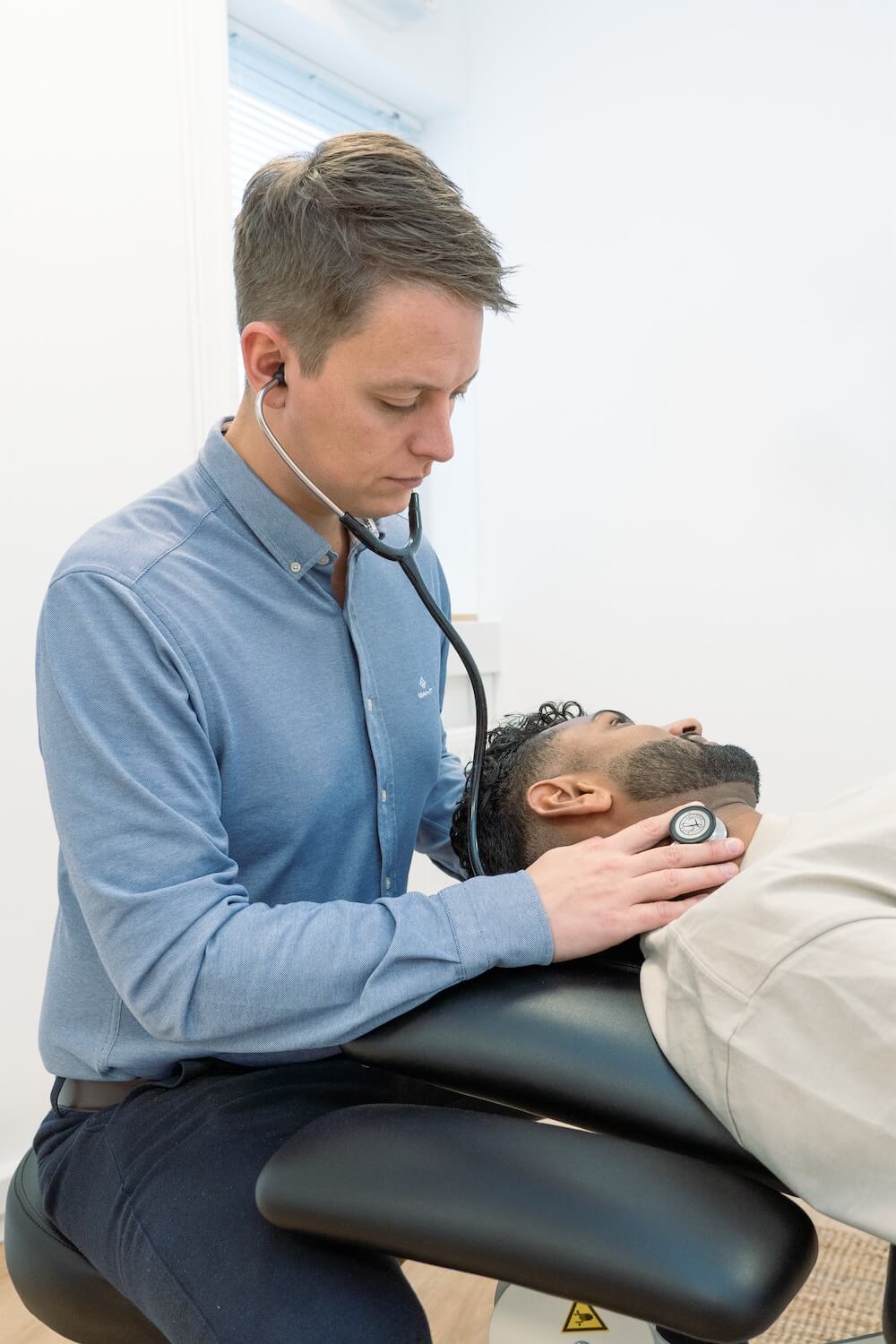We advise on problems from
Nicotine's impact on exercise
How does nicotine affect exercise?
Most people know that smoking is harmful to lung function and can thus affect performance in various sports because it inhibits the uptake of oxygen during aerobic work.
But how do smokeless nicotine products affect our training?
Jump to section [Vis]
What does nicotine mean for the body’s healing?
There are some who play sports and smoke, and the trend for this is increasing. This is seen in sports clubs all over the world – both in sub-elite and elite sports. There have also been examples of people who have used nicotine as part of their warm-up for their sport.
There may be an understanding among people that smokeless nicotine products are not harmful and may even enhance performance. But how does it really work?

The effect of nicotine on our body
Nicotine affects receptors for acetylcholine in the body, which is a neurotransmitter that affects the parasympathetic nervous system, the part of the nervous system that is dominant when we relax. This means that nicotine can, among other things, increase sweat production, nausea, increased mucus formation and promotes peristalsis in the intestinal system and is thus a laxative. These symptoms may seem familiar to people who have just been introduced to nicotine for the first time.
At the same time, however, the secretion of dopamine in the brain is also affected, which is another neurotransmitter. It is also called the reward system and is a substance that makes us feel good. It is the same neurotransmitter that is affected by, among other things, cocaine and amphetamine and is also secreted by, for example, gambling addiction. This is also why nicotine is highly addictive.
Dopamine affects the body differently than acetylcholine. It affects the secretion of the hormone noradrenaline, which affects our sympathetic nervous system – the part of the nervous system that is dominant during stress. This means, among other things, increased concentration, increased blood pressure and pulse, and reduced feelings of fatigue. It is therefore almost the opposite effect to acetylcholine.
Other central stimulants such as amphetamine, ephedrine and cocaine are prohibited in connection with sporting activities due to a performance-enhancing effect – but nicotine, as described, has a more mixed effect on the body.
(Source: Sundhed.dk)
We offer Functional Medicine consultations, where you can learn whether your body is getting what it needs, based on blood tests.
Negative and potentially positive effects
WADA (World Anti-Doping Agency) is currently investigating whether nicotine is a performance enhancer. A small study has been able to show a performance enhancing effect for people who are already users of nicotine products, but that it only brings them up to their “normal” level. If at some point there is evidence of a clear performance enhancing effect, nicotine could be considered for inclusion on the doping list. (Source: WADA).
Other effects of nicotine include narrowing of arteries and blood vessels – that is, negatively affecting blood to and from, for example, working muscles. This means, for example, that the muscles do not receive the same amount of oxygen and nutrients and do not transport waste products away from the muscles to the same extent.
Nicotine also negatively affects nerve communication in the muscles and thus the ability to, for example, coordinate movements and balance. This can increase the risk of acute sports injuries. The maximum muscle strength is also reduced in connection with nicotine, because the cross-sectional area of the muscles is reduced.
So in other words, there are some negative effects of nicotine, but perhaps also some performance-enhancing ones, so in relation to acute sports performance, the conclusion is not clear.

Longer-term effects
When you train, you put strain on the body’s muscles, joints, tendons, bones and cartilage. Immediately after training, these structures break down. The body then overcompensates and strengthens the stressed structures more, so that after a short dive you actually end up with a stronger starting point. This is also called a form curve. In addition to the stressed tissue itself, there is also an improvement in vascularization, neural drive, the number of red blood cells in the blood, etc.
For example, overtraining will result in a gradual deterioration of the tissue that is being stressed, instead of a positive fitness curve. This can ultimately lead to overuse injuries. Sports injuries can also occur acutely in connection with, for example, falls or twists, where tissue damage can occur.
Healing in the body depends both on good blood supply to supply building blocks to the damaged tissue, but also on good drainage to excrete waste products and metabolites from damaged tissue.
Blood supply is also important in terms of being able to supply white blood cells to the tissue, which as part of the immune system are responsible for reconstruction, after any injury.
Nicotine constricts the blood vessels and arteries in the body, thereby inhibiting blood flow and drainage from damaged tissue. It also increases the viscosity, or thickness, of the blood and thus its ability to flow to the tissue through the small blood vessels.
Support recovery after training: Diet
Depending on the temperature in which you train and the sport, you excrete between 400ml-800ml of fluid per hour during exercise through sweat.
It is important both during and after exercise to prevent dehydration and restore fluid balance in the body.
Depending on the duration and intensity, it may also make sense to consume salt during or after exercise to also maintain salt balance. It is actually recommended that you consume approximately one and a half times the amount of fluid you have excreted during exercise.
During exercise, the body’s carbohydrate stores are also depleted. Therefore, it may make sense to consume carbohydrates – preferably easily absorbed – right after exercise to stimulate the rebuilding of muscle glycogen stores quickly. This is especially beneficial if you train with a short time between sessions.
During exercise, tissue is broken down and then needs to be rebuilt. That’s why it’s a good idea to consume protein. People who do strength training are recommended to consume about 1.5 – 2 g. of protein per kilogram of body weight daily – preferably 10 g. immediately after exercise. You can get by with a little less if you do endurance training, namely about 1.2 -1.6 g. of protein per kilogram of body weight.

Support recovery after training: Lifestyle
Ways to increase your recovery include sleep. When we sleep, growth hormone is secreted, which stimulates healing and rebuilding in our body. So a good night’s sleep – about 7-8 hours – is important.
In connection with sports injuries, it is also very important to retrain. This stimulates the reconstruction of the damaged tissue. However, it is important to find a balance so that the tissue, which may be weaker after the injury, is not simply overloaded once again.
Finally, it is important to regulate stress in everyday life. Stress can prolong the time it takes to recover from exercise and can affect the healing time after injuries because it can inhibit the immune system. Therefore, it makes sense to be more careful about overuse injuries during stressful periods and possibly reduce the intensity of training during these periods.

Often related problems

Kissing disease

Diabetes mellitus

Eye inflammation

Padel injuries

Sedentary work

Nicotine and exercise

Shingles

